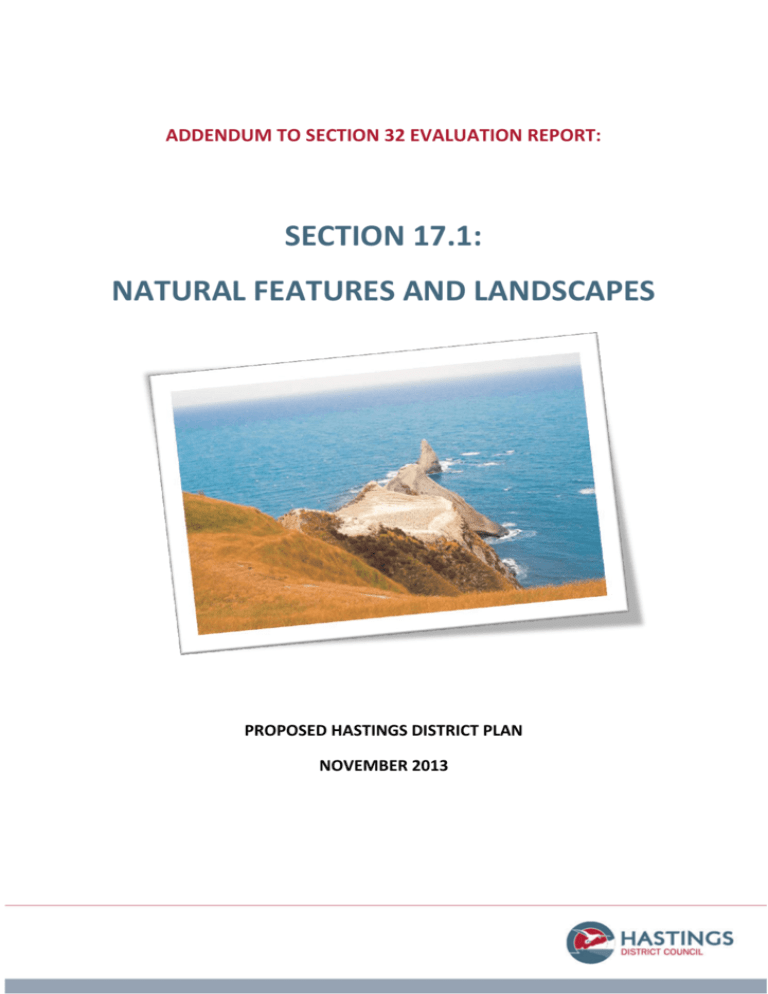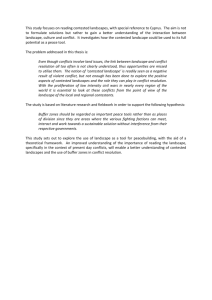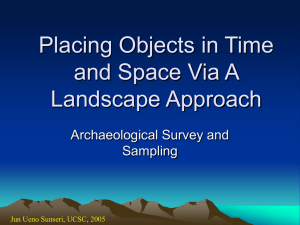section 17.1: natural features and landscapes
advertisement

ADDENDUM TO SECTION 32 EVALUATION REPORT: SECTION 17.1: NATURAL FEATURES AND LANDSCAPES PROPOSED HASTINGS DISTRICT PLAN NOVEMBER 2013 Section 32 Evaluation: Section 17.1 – Natural Landscapes and Features Proposed Hastings District Plan ADDENDUM TO SECTION 32 EVALUATION SECTION 17.1 – NATURAL LANDSCAPES AND FEATURES INTRODUCTION A Section 32 Report on the Natural Landscapes and Features provisions for the Reviewed District Plan was completed by consultants Boffa Miskell Ltd. This addendum to the Section 32 Report has come about as a result of the internal review of the section. This has resulted in some amendments to the Natural Landscapes and Features section (17.1). The amendments apply to the provisions of the Draft District Plan, to which the Boffa Miskell Section 32 Report was prepared for. There have also been some amendments made as a result of the submissions received on the Draft plan and these are also included in this S32 Addendum. This addendum report only deals with the changes that have occurred as a result of the review and submissions received on the Draft District Plan. The changes are principally associated with the Policies however for completeness sake the Objectives to which the policies relate have also been included. Where provisions have been deleted this is shown as strikethrough and new content has been identified as such. Objective Number Objective Appropriateness LSO 1 The natural and cultural factors, values and associations that define the Districts outstanding natural features and landscapes are identified, and protected from inappropriate subdivision, use, and development. The matters of national importance under the RMA dictate that the Council must recognise and provide for the protection of outstanding natural features and landscapes from inappropriate subdivision, use, and development. Landscapes are an important issue for the District. Page 1 Section 32 Evaluation: Section 17.1 – Natural Landscapes and Features Proposed Hastings District Plan Policies, Rules and Other Methods Number Policies Rules and Other Efficiency Methods (Costs and Benefits) (Summary) Effectiveness (Consequences/risks) LSP1 Recognising Outstanding Natural Features and Landscapes (ONFL) and their factors values and associations by assessing the extent to which criteria are met Allows for transparent and straightforward communication of key factors that lead to classification. Current provisions do not set out the basis for evaluation. Explicitly identifies the factors taken into account and provides a framework for consistent implementation. Factors are drawn from case law and best practice methods. Consistent with adjacent Regional and District Plans and policies. LSP2 Providing for the protection of the particular factors, values and associations that make an area an outstanding natural feature and landscape from the adverse effects of inappropriate subdivision, use and development, by considering a range of matters including place specific management issues. Explicitly identifies the matters that will be considered in any applications for resource consent The current plan provisions are generic and do not provide clear guidance and what effect will be taken into consideration. Consistent with adjacent Regional and District plans and policies. Although this Policy was not in the Draft Plan it has been carried over from the Operative District Plan. Consistent with cultural values. As stated in the Costs and Benefits column the range of matters are those that will be considered in any applications for resource consent and therefore these matters should not be policy and are better placed as Assessment Criteria for consent applications applying to Outstanding Natural Features and Landscapes. New Policy LSP2 “Protection of the present landscape qualities of Te Mata Peak shall be afforded the highest priority through the District Plan” As the most highly visible landscape in the District and the one that is subject to the most pressure this policy will make it clear that it is afforded the highest level of protection. Provides certainty Page 2 Establishes policy for explicit identification of no build 240m contour line and controls for building below this level. Section 32 Evaluation: Section 17.1 – Natural Landscapes and Features Proposed Hastings District Plan to both landowners and the community. Maintains current plan policy and gives effect to Objective LSO1 and the purpose of the Act, including specifically section 6(b). A cost is that it could establish a platform for comparison against other Outstanding Landscapes. New Policy LSP3 “Buildings, Plantations, Earthworks and Network Utilities will be restricted on Identified Outstanding Natural Landscapes throughout the District.” Although this Policy was not in the Draft Plan it has been carried over from the Operative District Plan. Provides for integrated management of the landscape resource. Clearly signals the type of activities that are likely to adversely impact on the Outstanding Natural Landscapes and Features. Maintains current plan policy Ties in with the assessment criteria in the Earthworks and Network Utilities Sections. Explicit assessment criteria for these activity types are included in this section of the Plan. Will require those involved in these types of activities to make resource consent and carefully assess the effects of the activity on the landscape and consider alternatives. This will be effective in achieving a positive outcome for the landscape or natural feature. Supports regulation which has the effect of being an increased cost to developers. New Policy LSP4 “Subdivision on land within an Outstanding Natural Feature and Landscape identified in Appendix 43 of the District Plan shall have regard to the impact of the subdivision or possible activities that may occur as a result of the subdivision undertaken.” Although this Policy was not in the Draft Plan it has been carried over from the Operative District Plan. Provides for integrated management of the landscape resource. Allows consideration to be given to the land use effects that will arise as a result of the subdivision process. Provides clear direction to landowners and developers of land affecting an Outstanding Natural Landscape or Feature that a change of activity status may occur as a result of the subdivision. Page 3 The effectiveness of this policy is reinforced by the controlled activity status complying for subdivision generally insofar as consent will be require. Although a controlled activity consent must be granted so there is limited discretion in the landscape effects that can be considered for a complying subdivision. Most of the District’s Outstanding and Significant Landscapes are in the Rural Zone. In this zone the creation of rural lifestyle sites has a restricted discretionary nonnotified status with an ability to consider landscape effects and therefore put into effect this policy. Higher activity status also apply in Section 32 Evaluation: Section 17.1 – Natural Landscapes and Features Proposed Hastings District Plan specific Outstanding Landscapes. Maintains current plan policy New Policy LSP5 “All subdivision land development activities will be encouraged to have regard to the landscape features and character of the site and locality.” Although this Policy was not in the Draft Plan it has been carried over from the Operative District Plan. Allows consideration to be given to the land use effects that will arise as a result of the subdivision process. Can provide an opportunity to educate the landowner ahead of development of the site. The Council has produced a Good Practice Landscape Guideline for Subdivision and Development that is a good education tool to encourage developers to avoid or mitigate the effects of their development on the landscape. This is referenced in the subdivision section methods helping to give effect to this policy. Maintains current plan policy Objective Number Objective Appropriateness LSO 2 The other matters under the RMA dictate that the Council must have particular regard to the maintenance and enhancement of amenity values. Landscapes are an important issue for the District and provide identity and sense of place and help to enable the community to provide for their social, cultural and economic wellbeing. The values that define the District’s Significant Amenity Landscapes are identified, maintained, and enhanced. Policies, Rules and Other Methods Number Policies Rules and Other Methods (Summary) Efficiency (Costs and Benefits) Effectiveness (Consequences/risks) New Policy LSP8 Although this Policy was not in the Draft Plan it has been carried over from the Operative District Plan. This is a new policy added to the Proposed Plan as the Draft District Plan had no policy to give guidance on the matters that need to be considered when subdivision and development is taking place within the Significant Amenity Landscapes. It is important such policy guidance to be provided. Subdivision, use and development on Rural residential zoned land in the Significant Amenity Landscapes identified in Appendix 44 of the District Plan should be of a type, scale design, and location that maintains the key landscape elements, patterns and character which contribute to the character of these areas. Maintains policy. current plan Subdivision and land use will be based around the visual quality and character of the SAL areas. As many of the SAL areas adjoin the Outstanding Page 4 Section 32 Evaluation: Section 17.1 – Natural Landscapes and Features Proposed Hastings District Plan Natural Landscapes and Features this policy will assist in maintaining and enhancing the landscape in the ONFL’s. Objective Number Objective Appropriateness LSO3 The other matters under the RMA dictate that the Council must have particular regard to the maintenance and enhancement of amenity values. Landscapes are an important issue for the District and sense of place and help to enable the community to provide for their social, cultural and economic well-being. The values that define the District’s Rural and Coastal Landscape Character Areas are identified, maintained, and enhanced. Policies, Rules and Other Methods Number Policies Rules and Other Methods (Summary) Efficiency (Costs and Benefits) Effectiveness (Consequences/risks) LSP6 LSP9 Areas are identified based on visual quality and character. The Operative District Plan makes no provision for control of development in areas that have landscape character that is highly valued by the community but falls outside the ONFL and SAL classification. Identifying Rural and Coastal Landscape Character Areas where broad areas are highly valued for their cultural patterns of land use, rather than their natural landscape values. Identifies the general scope of matters that will be considered in applications for subdivision consent. For land use, the underlying land use control methods are considered generally appropriate, particularly in the context of tighter control of urban development signalled through HPUDS. Larger scale rural uses such as rural industry or out of zone activities would require resource consent or plan changes that would provide the scope to consider landscape matters. Page 5 The primary impact on cultural patterns of use is shaped through subdivision. For character areas that are valued more for their cultural patterns, the expectation is that the landscape will continue to evolve over time and that needs of working landscapes should be clearly recognised. In these circumstances the most appropriate control is generally at the time of subdivision where cumulative effects of development and land use can be influenced for the long term. Section 32 Evaluation: Section 17.1 – Natural Landscapes and Features LSP7 Maintaining the character and amenity values that make an area a Rural or Coastal Landscape Character Area by guiding and controlling site development and layout that may have a significant cumulative effect on those values. This policy has been deleted as it is largely covered by the Policy above (LSP9).The wording of this policy is an appropriate explanation of what is to be achieved by Policy LSP9 and has been included in the Plan as such. Identifies the general scope of matters that will be considered in applications for subdivision consent. For land use, the underlying land use control methods are considered generally appropriate, particularly in the context of tighter control of urban development signalled through HPUDS. Larger scale rural uses such as rural industry or out of zone activities would require resource consent or plan changes that would provide the scope to consider landscape matters. Proposed Hastings District Plan The primary impact on cultural patterns of use is shaped through subdivision. For character areas that are valued more for their cultural patterns, the expectation is that the landscape will continue to evolve over time and that needs of working landscapes should be clearly recognised. In these circumstances the most appropriate control is generally at the time of subdivision where cumulative effects of development and land use can be influenced for the long term. AMENDMENTS AS A RESULT OF SUBMISSIONS TO THE DRAFT PLAN. Additional Rule - LS3 Plantations up to a vertical distance of 40 metres below the ridgeline – Permitted Activity A submission received on the Draft Plan stated that the Plan has rules that prevent plantations being established on Outstanding Natural Features and Landscapes but that there should also be a rule that prevents plantations on the ridgelines of the Significant Amenity Landscapes. This relates to Objective LSO2 Policies, Rules and Other Methods Number Policies Rules and Other Methods (Summary) Efficiency (Costs and Benefits) Effectiveness (Consequences/risks) New Rule LS3 This rule will recognise the impact that the plantations can have on skyline views of the landscape in various locations. It will be effective as this rule targets only those Significant Amenity Landscapes that have identified the retention of the open uninterrupted skyline along the hillside as an issue applying to it. There is no standard for planting below the ridgeline for the majority of the SAL’s. Plantations up to a vertical distance of 40 metres below the ridgeline. The rule recognises the qualities of those SAL’s that have dominant skyline views and will meet objective LSO2. There will be a cost of loss of production to landowners as a result of the rule being implemented. Page 6 Section 32 Evaluation: Section 17.1 – Natural Landscapes and Features Proposed Hastings District Plan Additional Rule – LS4 Underground lines associated with Network Utilities– Permitted Activity A submission received on the Draft Plan requested that consideration be given to allowing the undergrounding of lines associated with Network Utilities as a permitted activity. This relates to Objective LSO1 Policies, Rules and Other Methods Number Policies Rules and Other Efficiency Methods (Costs and Benefits) (Summary) Effectiveness (Consequences/risks) New Rule LS4 While the undergrounding of the utilities will have long term positive effects on the landscape the issue of the effects of the undergrounding process are not considered. There is a risk that the earthworks associated with the undergrounding could have a significant impact on the landscape values in the short term especially if there are no reinstatement conditions. Underground lines associated with Network Utilities. Permitted Activity in ONFL2-8 and SAL 1-9 This rule recognises the difficulty faced by Network Utility Operators in establishing their infrastructure in the most efficient way while avoiding or mitigating the effects on the landscape. The rule may incentivise the network utility operators to underground operations resulting in an improvement to the visual amenity of the ONFL’s and SAL’s. Page 7









